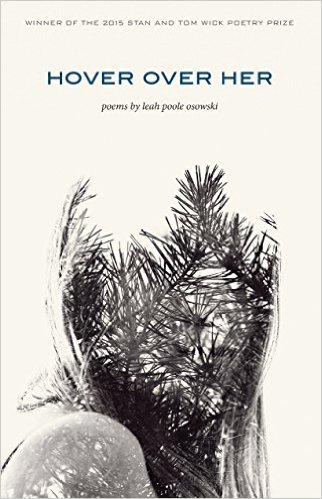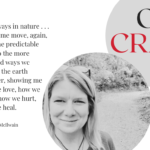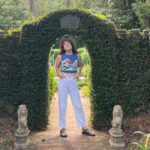Leah Osowski’s poem “Vs. Field” is forthcoming Issue 13.2. In today’s blog post, Associate Editor José Angel Araguz reviews Osowski’s collection, Hover Over Her.
 While reading Leah Poole Osowski’s Hover Over Her, I found myself coming back to the phrase “the poetics of suddenness.” Throughout the collection, moments are built up into a spark and flash of imagery and linguistic resonance, so that often a reader is engaged in the act of keeping up with the poem as it happens. These lines from “For the Unrealized Girls” serve as a brief example of how this kind of suddenness works:
While reading Leah Poole Osowski’s Hover Over Her, I found myself coming back to the phrase “the poetics of suddenness.” Throughout the collection, moments are built up into a spark and flash of imagery and linguistic resonance, so that often a reader is engaged in the act of keeping up with the poem as it happens. These lines from “For the Unrealized Girls” serve as a brief example of how this kind of suddenness works:
—the throb that comes the first time
an earlobe is sealed into the envelope of a mouth,
the beating wingspan of an owl under-chest—
The juxtaposition of physical descriptions here, from human to animal, is executed in such a way that both come alive simultaneously. The human acts are imbued with that of the animal, and vice versa; these twin moments of intensity push the lyric to a sudden level of emotion, lingering there before moving on.
In “Three Girls and Something Like Hovering on a Hill in Vermont” this same suddenness works as a narrative engine. This poem begins by contextualizing the lives of three girls via ideas of motion:
They’ll take more walks in this phase than any other—
the budding years right before driver’s licenses
just after boundaries…
These three lines paint a picture indirectly; rather than an age, the reader is given before and after. In this gesture, one can read the title’s “hovering” as pointing to a state of being indefinable. From here, the liminal energy of youth carries the poem forward through various details of the three girls’ respective lives, culminating at the end in images whose succession and immediacy have a meaning on the level of near physical sensation:
…There’s homemade
dandelion wine in the top cabinet. A little brother
grasping a fly swatter. A rooster hung from a cypress,
bleeding out in a kill cone. Most of the poplar stairs
lick the girls’ bare feet as they lightning past.
Here, the velocity of the three girls’ lives is mirrored in the speed of the narrative. Meaning and narrative happen in confluence through juxtaposition, the story realized through each image and phrasing registered. In a poem where a little brother is presented poised on the edge of violence, and a rooster hangs as a victim of violence, the image and sensation of the last line resonate with a mortal urgency.
This urgency is also present in a series of prose poems from the perspective of various inanimate objects. The poem “Blood Speaks of the Heart” begins:
It’s like coming home. Like running through a corn maze. Like the Vatican. But it really depends on which side you’re in, the blood gushes. If your next stop are the lungs then it feels like you’re climbing so many flights of stairs at an area of high elevation. And if you just came from the lungs it’s like a dance party in the atrium where nobody ever gets tired and the music is pumping and the energy is so high that the crowd always spills out into the streets and takes to sprinting…
Here, the imaginative leaps serve to redefine the biological working of blood via metaphor. This redefining becomes another kind of hovering, pushing against expectation through the conceit of blood speaking. Yet, metaphor and conceit necessarily push the poem back to its human terms:
And what about love, we ask? The blood gets real quiet. It whispers, we’ve heard of that version of the heart, we’ve heard it lives upstairs. And then in a barely audible murmur, like heaven lives upstairs up from you.
In this back and forth between blood and the speaker, one can see with what suddenness the redefining and reimagining impulse can be curbed. Osowski’s ability to evoke both exuberance and pathos within this conceit makes for an engaging reading experience.
The ambition of this poetic of suddenness can be seen in the emotional range of the poems discussed. Like the hovering implied in the collection’s title, a poem becomes a space where reader and writer can linger and consider experience. In Osowski’s hands, a poem is a way to reach after, but not hold or restrain, experience. Suddenness, then, becomes a way to do this work. The speaker in the sequence “Moonstone” asks a telling question:
10. You think you know the shade of someone once your body has laid next to theirs a certain number of times. But then the question arises—what color, if any, are they when the light goes out?
As the reader lingers in both the physical and conceptual dark of the speaker’s question, inklings of how unanswerable this question is and why begin to crack through. The speaker goes on to end the poem with an image of what it feels like to hover such questions:
11. Snow angels in a blizzard.
interview
JAA: How would you say this collection reflects your idea of what poetry is/can be?
 LPO: This summer I lived at a camp in the woods next to a lake. A larger lake nearby spit out rocks perfectly smooth and flat. I wrote the word “transformation” on one and kept it on the table in the center of the cabin. I believe poetry transforms experience. It’s a way of accessing memory and image through a layer of language. And language has a mind of its own. It can render reality optional, persona flexible, and insert rooms into the smallest details. All day we walk around with gravity and a whole slew of rules that apply to this world—poetry transcends those limitations, so when you have an art form that can do that you must. Poetry also tends to corral your preoccupations and obsessions, sometimes subconsciously. In that way, we access what’s pawing at us, herd it all into a fenced-in area, and hope to calm it down. But back to that lake stone: by adding words to the natural world we aim to understand it, or maybe just increase our proximity.
LPO: This summer I lived at a camp in the woods next to a lake. A larger lake nearby spit out rocks perfectly smooth and flat. I wrote the word “transformation” on one and kept it on the table in the center of the cabin. I believe poetry transforms experience. It’s a way of accessing memory and image through a layer of language. And language has a mind of its own. It can render reality optional, persona flexible, and insert rooms into the smallest details. All day we walk around with gravity and a whole slew of rules that apply to this world—poetry transcends those limitations, so when you have an art form that can do that you must. Poetry also tends to corral your preoccupations and obsessions, sometimes subconsciously. In that way, we access what’s pawing at us, herd it all into a fenced-in area, and hope to calm it down. But back to that lake stone: by adding words to the natural world we aim to understand it, or maybe just increase our proximity.
JAA: What were the challenges in writing these poems and how did you work through them?
LPO: I tend to begin poems on a line or an image and let the language take over and drive the content. I wrote most of the poems in this book in a 2 ½ year period and it wasn’t until the end of that time that I laid them out to witness the conversation they were having. The challenges weren’t in the individual poems but how they were working as a collection. I realized that the narrative backbone of this book is the poems about the “three girls” and their arch needed some shaping. But when I tried to write a prescripted poem it fell apart. The lack of spontaneity results in a dulling of luster. I’d write them and my boyfriend, who’s also a writer, would tell me they were terrible, and I’d go back in and mess up their hair. They’re like kids in that way—if you try to dress them up and keep them neat by the end of the day there’s grass stains and bruises and four wardrobe changes. Poems, like all living things, need their freedoms, and the challenge is in allowing that to happen while steering a collection towards cohesion.
*
Hover Over Her is available for purchase from The Kent State University Press.
To find out more about Leah Poole Osowski’s work, check out her site.











